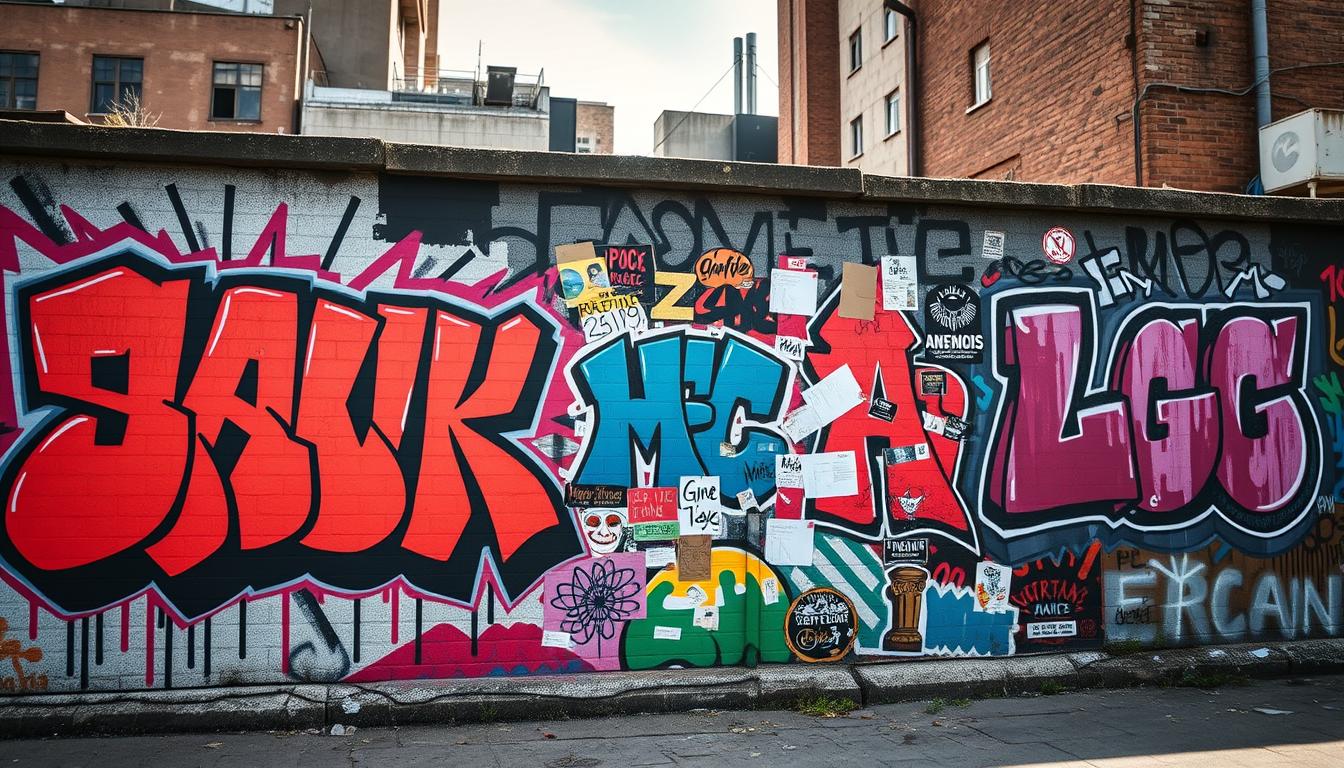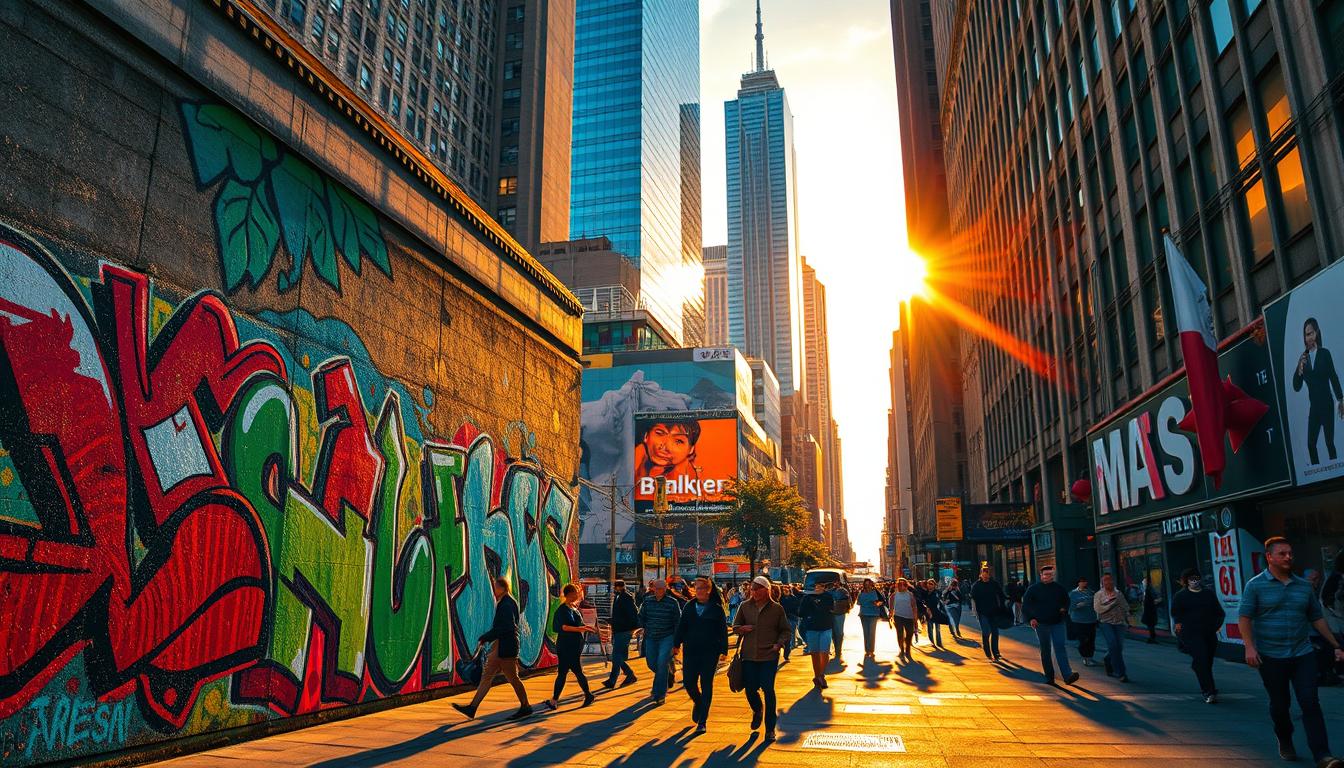Can a painted wall change how a neighborhood thinks? This question opens a look at public creativity and civic voice.

Public visibility is central. Works on buildings, bridges, and underpasses reach people who may not visit galleries.
Site, timing, and audience shape meaning. Quick techniques like stenciling, wheatpaste, and projections suit urban surfaces and fast creation.
Ephemerality matters. Weather, cleanup, and redevelopment can erase pieces, giving them urgency and a living timeline.
The movement blends unsanctioned interventions with commissions and festivals. Artists such as Banksy and Shepard Fairey show how individual voice builds global recognition.
In short: place, intent, materials, and social messaging form the core of this public expression and its impact on society.
Key Takeaways
- Visibility in public spaces gives this practice its power and reach.
- Site-specific work and temporary life shape meaning for local people.
- Techniques favor speed and adaptability to urban surfaces.
- Social and political messages drive conversation and civic reflection.
- Both illicit pieces and curated projects keep the movement dynamic.
Defining Street Art: Core Traits That Make It an Art Form
City walls carry messages meant for everyone who passes by.
Public visibility and accessibility turn murals and paste-ups into a shared cultural resource. Works live in public spaces, free to view, and meet people in daily routines rather than behind gallery doors.
Public context and site-specific meaning
Surfaces, traffic patterns, and neighborhood history shape how a piece reads. A mural on a transit hub reaches commuters; a tiny paste-up in an alley speaks to passersby who know that route.
Placement becomes part of the composition, so the city itself acts as the primary medium and platform.
Ephemerality and dialogue
Weather, cleanup, or redevelopment can erase work quickly. That decay is often intentional, making time and renewal part of the concept.
"The public life of a piece is its meaning—its appearance, aging, and removal all belong to the work."
- Mediums: spray paint, stencils, paste-ups, stickers, and projections enable speed and adaptability.
- Intent: many pieces prompt discussion, tackling social political issues and civic topics.
- Contrast: while tagging often marks territory, this practice aims for dialogue and shared experience.
| Trait | Typical Mediums | Audience | Lifespan |
|---|---|---|---|
| Public context | Murals, paste-ups | Broad, passersby | Months to years |
| Ephemerality | Stencils, stickers | Local community | Days to months |
| Commentary | Projections, wheatpaste | Civic audiences | Event-based |
| Gallery crossover | Canvas, prints | Collectors, visitors | Indefinite |
For a closer look at the defining qualities and history behind this practice, see the defining qualities explored in other sections.
From Tags to Movements: A Brief History of Street Art
Names and marks on trains began a quiet revolution in urban expression.
Early roots: In the 1920s–1930s, New York City and Philadelphia saw writers place name-based tags on trains and walls. These small acts claimed identity and moved through the city with each ride.
The graffiti boom of the 1960s–1980s expanded that impulse into full subway murals. Mobility and visibility became central, letting work reach people across boroughs.
Artists like Keith Haring and Jean-Michel Basquiat bridged graffiti and the gallery world. Their careers showed how practice from marginal places could enter museums and markets.
By the 1990s–2000s the movement spread worldwide. London, Berlin, São Paulo, and Melbourne adapted techniques to local buildings and surfaces. Online sharing sped that growth and built global networks of street artists.
| Period | Location | Key change | Impact |
|---|---|---|---|
| 1920s–1930s | New York City, Philadelphia | Early name tags on trains | Identity and territorial marking |
| 1960s–1980s | New York | Subway murals and large pieces | Wider public reach across the city |
| 1990s–2000s | Global (London, Berlin, São Paulo, Melbourne) | Local adaptation and digital spread | International movements and dialogue |
Materials and Techniques That Shape the Medium
Tools and tactics shape how public works meet a city’s pace and pulse.
Spray paint offers rapid coverage and bold color on rough urban surfaces. It suits quick execution and wide fields, letting artists cover walls fast while keeping contrast strong.
Stencils and wheatpaste deliver crisp graphics with minimal exposure time. They help produce repeatable styles that read clearly at a distance and across busy spaces.
Large works and time-based methods
Murals and installations need planning, permits, and scaffolding to transform corridors at scale.
Projections and video—exemplified by BLU’s mapped animations—turn facades into moving canvases that vanish with daylight, highlighting ephemerality.
- Stickers & fly-posting: portable forms that multiply presence and build identity through repetition.
- Guerrilla gardening: plants as interventions that mix ecology with visual impact.
- AR & digital archives: new surfaces that extend a piece’s life beyond weather and cleanup.
| Technique | Typical use | Strength | Lifespan |
|---|---|---|---|
| Spray paint | Large murals, quick tags | Speed, color | Months–years |
| Stencils / wheatpaste | Graphics, posters | Clarity, fast application | Days–months |
| Projections / video | Time-based facades | High visibility, no residue | Event-based |
| AR / digital | Online overlays and records | Longevity, shareability | Indefinite |
Each method balances speed, risk, and clarity. Technique choice aligns with message and context, reinforcing why this practice remains a distinct creative medium in Canadian and global cities.
Street Art vs. Graffiti: Boundaries, Intent, and Legality
Some marks claim territory; others invite the public into a shared exchange.

Graffiti often centers on tags, crews, and reputation. It communicates inside a subculture and can be illegal. Writers seek visibility and presence through quick marks.
Street art tends to aim for broader public dialogue. Pieces use imagery, humor, or narrative to engage people and prompt reaction. Work can be commissioned, permitted, or placed on approved walls to benefit a neighborhood.
Key contrasts
- Intent: graffiti stresses identity and territory; street art stresses communication and civic prompt.
- Legality: both can be illicit, yet many cities now set aside legal walls or programs.
- Audience: graffiti speaks to peers; street art reaches a wider public and society at large.
"Acceptance varies by place: policies, maintenance, and community consent shape how work is received."
New York City experimented with legal walls and curated programs that balanced risk with cultural value. Many artists began in graffiti crews and evolved into public-facing pieces without abandoning roots.
Ethics matter: respect for property, community input, and upkeep influence whether a piece is seen as civic benefit or vandalism. These distinctions guide festival curation, city policy, and the way galleries engage with public practice.
Repetition, Innovation, and Evolution in the Street Art Movement
When icons repeat, a city slowly learns to read an artist’s presence. Recurring symbols build recognition over time and map creators across neighborhoods.
Repetition becomes identity: Shepard Fairey’s HOPE motif and Invader’s tile mosaics show how repeated visuals register in public memory. These strategies turn single gestures into lasting urban signals.
Innovation expands the toolkit. BLU’s animation and projection work ties moving image to architecture. Mixed media—sculptural add-ons, paste-ups, and video—push boundaries beyond paint and stencils.
Many artists moved from covert walls to festival commissions and gallery projects. Events like Wynwood Walls and Upfest show how the movement adapts while keeping public audiences central.
Time and change keep practice dynamic. Redevelopment, cleanup, and new trends erase and remake city canvases, so pieces gain meaning through turnover.
- Recognition: repeat icons create citywide maps of influence.
- Experimentation: moving-image and mixed media broaden impact.
- Transition: illicit origins coexist with curated commissions and festivals.
"Evolution and innovation are what keep public practice relevant and urgent."
Themes That Define Street Art’s Message
In many cities, visual interventions turn corners into forums for debate about power and belonging. Public images compress big topics into simple signs that invite people to respond.

Social and political commentary: protest, resistance, and activism
Social political issues often drive murals and quick paste-ups. Artists use bold symbols, satire, and juxtaposition to turn blocks into open forums for dissent and dialogue.
Identity, community, and cultural storytelling
Neighborhood projects honor local histories. Murals and workshops help communities tell shared tales and preserve memory in public view.
Humor, irony, and subversion as visual strategies
Humor disarms. Irony and subversion let creators present sharp critique without heavy jargon. This makes commentary readable and shareable across the world.
- Accessibility: public placement ensures messages reach diverse audiences.
- Overlap: some graffiti roots remain, but wider address shifts the way works speak to society.
- Participation: community murals and events expand impact beyond a single wall.
"When visuals meet the public, civic conversation often follows."
Result: These themes shape civic function, keeping public practice urgent, visible, and relevant to cities, tourism, and creative industries.
Impact on Cities, Culture, and the Art World
A single coordinated mural project can reframe how people use and value public spaces. Walls and buildings that once felt neglected become magnets for foot traffic, small business growth, and local pride.
Transforming neighborhoods: murals, festivals, and tourism
Murals and curated festivals reactivate blocks. Events like Wynwood Walls and Bristol's Upfest show how coordinated works turn districts into cultural destinations.
Outcomes: more visitors, new cafes and galleries, and measurable increases in local spending.
Influence on design, fashion, advertising, and film
Design and branding borrow bold graphics, handmade textures, and kinetic paint styles to signal authenticity. Films such as Spider-Man: Into the Spider-Verse draw on layered paste-ups and vivid palettes for visual energy.
Permission, commissions, and the gallery crossover
Many cities now balance permits and community projects to protect public interest while supporting creators. Artists move between walls and galleries, translating civic practice into studio work without losing street-facing roots.
- Placemaking: integrated programs use murals to boost cultural tourism and civic pride.
- Economics: festivals drive direct spending and longer-term investment in buildings and retail.
- Tension: concerns about commercialization and graffiti histories persist even as new platforms grow.
| Impact | Example | Measure |
|---|---|---|
| Neighborhood activation | Wynwood Walls | Visitor numbers, new businesses |
| Industry influence | Fashion & film | Visual trends, campaign styles |
| Art world acceptance | Gallery shows | Sales, exhibitions |
"Public visibility, immediacy, and relevance to daily life make these works catalysts for real urban change."
Who Defines Street Art: Artists, Works, and Iconic Moments
A handful of artists and their emblematic pieces turned walls into global conversations.
Banksy made simple stencils with sharp commentary that reach far beyond galleries. His "Girl with a Balloon" became a global symbol of hope and loss. When a framed version partially shredded at auction, it forced a public debate about commercialization and value.
Shepard Fairey blended graphic repeat motifs and political messaging. The 2008 HOPE campaign poster moved street techniques into mainstream politics and showed how a single image can define a campaign.
- Keith Haring: public murals that championed joy, equality, and community.
- Jean-Michel Basquiat: from downtown graffiti in New York City to museum acclaim.
These figures used repetition, clear message, and public impact to build recognition across cities. Techniques like stencils, paste-ups, and quick paint kept visuals legible and fast to place.
"Direct, legible visuals and repeated icons make messages travel — shaping policy, design, and public taste."
Result: These artists and their works show how consistent imagery and accessible content cement names in public memory and move local practice into the world stage.
What defines street art as an art form
When images leave the gallery, they enter civic conversation and routine.
Public-first: works appear in cities and shared spaces, making the platform itself part of the piece.
Context shapes meaning. Where a work sits—on a transit hub, alley, or block—changes how people read it.
Ephemerality matters. Weather, cleanup, and timing mean removal and decay are part of the aesthetic.
The movement began in tagging and graffiti history but widened into commissioned projects and gallery crossover. That history keeps its public purpose intact.
Accessibility and dialogue are core: anyone can encounter and respond in real time, often about social political issues.
- Clarity, scale, and repetition make works legible to diverse audiences.
- Materials and methods favor speed, adaptability, and urban durability.
- Legal status varies, yet intent to provoke civic exchange remains constant.
"Place, time, intent, and audience together mark this practice as a living, public art form."
| Trait | Why it matters | Typical result |
|---|---|---|
| Public-first platform | City fabric becomes medium | Immediate, shared encounters |
| Site-specific context | Location guides interpretation | Stronger local relevance |
| Ephemerality | Time becomes part of meaning | Urgency and renewal |
| Roots and crossover | History informs approach | Broader cultural reach |
Conclusion
Bold visuals in shared spaces shape daily life and local memory. Public visibility, site context, and quick methods keep murals and paste-ups tied to city rhythms. Ephemerality and repetition turn walls and buildings into civic stages for works that travel by image and story.
From New York roots to global festivals like Wynwood Walls, the movement evolved into a recognized practice that still speaks in public. Galleries and commissions coexist with guerrilla pieces, while tensions with graffiti and commerce remain part of the debate.
Celebrating artists and community partnerships shows how message-driven, accessible visuals inspire change and pride. Look for the next stencil or mural on your city streets—these living pieces keep writing history and inviting response.
Enhance Your Space with Unique Modern Masterpieces
Are you inspired by the innovative mediums and conceptual depth highlighted in our exploration of contemporary art? You’re not alone! Today’s art enthusiasts are seeking cultural relevance and emotional connections in their artwork. However, finding pieces that resonate with modern themes and fit your unique style can be a challenge. That’s where we come in!
At Rossetti Art, we specialize in canvas prints, original paintings, and modern sculptures that celebrate the spirit of now. Each piece created by Chiara Rossetti brings a personal touch that connects deeply with current social narratives—just like the modern masterpieces discussed in the article. Don’t miss out on the chance to elevate your home decor with breathtaking artwork that speaks to your values and aesthetic. Explore our collection today and find your perfect piece! Act now, and transform your space into a gallery of inspiration!
FAQ
How can public visibility and accessibility make urban works meaningful?
Publicly placed pieces reach broad audiences outside galleries. Visibility turns walls, trains, and plazas into stages where messages meet daily life. This access shapes interpretation and invites community responses.
Why does ephemerality matter for murals and other pieces?
Temporary displays force immediacy. Weather, removal, and repurposing change the lifespan of a work, giving it urgency and site-specific meaning tied to time and place.
Where did modern street practices begin and how did they spread?
Early momentum rose in New York City and Philadelphia with tagging and subway murals. From there it spread internationally to cities like London, Berlin, São Paulo, and Melbourne, evolving through local scenes and cross-border exchanges.
What tools and techniques shape urban creations today?
Artists use spray paint, stencils, wheatpaste, stickers, and large-scale mural paint. Installations, projections, and guerrilla gardening broaden the toolkit, while digital archiving and AR add new layers.
How do tagging and large murals differ in intent and reception?
Tags often mark territory or identity, while large murals usually aim for public dialogue or storytelling. Legal status can differ, with some works commissioned and others illicit, which affects how communities respond.
In what ways does repetition serve creators and neighborhoods?
Repeated motifs build recognition for individual creators and can anchor neighborhood identity. At scale, repetition turns single images into visual landmarks and cultural markers.
What innovative methods are changing public practice now?
Video projections, animated installations, mixed-media interventions, and augmented reality expand how pieces interact with viewers. These methods let artists experiment with movement, time, and interactivity.
How do themes like protest and identity show up in works on buildings?
Visual language often tackles social and political issues, reflecting protest, resistance, and community stories. Humor and irony provide accessible entry points while layered symbolism speaks to specific audiences.
What impact do murals and festivals have on neighborhoods?
Large-scale projects and events can boost tourism, spark local pride, and invite investment. They also risk gentrification pressures, so community involvement matters for equitable outcomes.
How has this scene influenced commercial design and media?
Visual styles from murals and posters influence fashion, advertising, and film. Designers borrow bold typography, stenciling, and collage approaches for wider cultural reach.
When do works move from streets into galleries and commissions?
As recognition grows, institutions and brands may commission artists or acquire pieces for galleries. This crossover raises questions about context, authorship, and audience.
Who are some influential figures and iconic moments in the movement?
Notable practitioners include Banksy, Shepard Fairey, Keith Haring, and Jean-Michel Basquiat. Iconic images like "Girl with a Balloon" and Fairey’s HOPE poster shaped public perception and mainstream interest.
How do political campaigns and public messaging interact with urban visuals?
Campaigns and social movements use large-scale imagery to reach voters and communities. These visuals can mobilize, provoke debate, and become part of collective memory.
What role does documentation play in preserving temporary works?
Photography, video, and online archives preserve moments that physical pieces may lose. Digital records help scholars, curators, and fans study evolution and influence across time and place.






Leave a comment
This site is protected by hCaptcha and the hCaptcha Privacy Policy and Terms of Service apply.